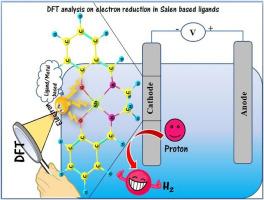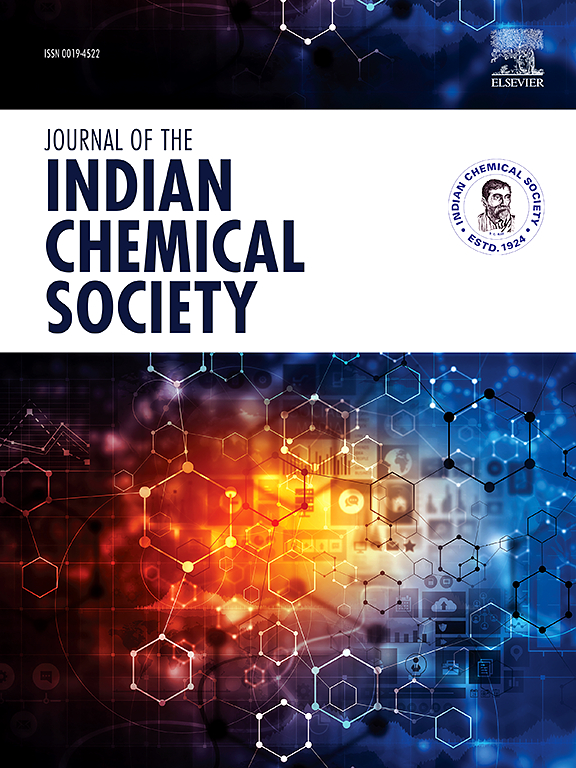对 M-Salen 和 M-Salphen 电催化剂的电子和结构特性进行 DFT 研究,以实现有效的 HER
IF 3.2
4区 化学
Q2 CHEMISTRY, MULTIDISCIPLINARY
引用次数: 0
摘要
我们采用密度泛函方法报告了 Salen(N,N'- 双水杨醛乙二胺)和 Salphen(N,N'- 双水杨醛苯二胺)配体的电化学性质。研究探讨了参与氢进化反应的金属化 M-Salen 和 M-Salphen 配体(其中 M = Sb & Mo)的结构和电子特性以及还原电位。在 B3LYP/6-31+G(d, p) & LANL2DZ 理论水平上获得了所选金属化配合物的优化几何结构。在相同的理论水平上,使用类似导体的可极化连续体模型(CPCM)考虑了溶剂乙腈存在时溶解对 M-Salen 和 M-Salphen 系统电化学特性的影响。在还原过程中,发现金属中心 Mo 和 Sb 以及配位层中的 C、N 和 O 原子周围的电荷分布发生了很大变化。由于第一个未占用轨道 LUMO 与电子亲和力直接相关,因此在 Mo 取代的 Salen 和 Salphen 配体中观察到的 LUMO 负值较大,这表明它们能够表现出更好的还原过程。M-Salen 体系的计算还原电位值从 -2.23V 到 -0.62V,因此 M-Salen 配体的催化活性按照 Mo-Salen > Sb-Salen > Salen 的顺序排列,在 M-Salphen 体系中也观察到了相同的趋势,Mo-Salphen 体系的还原电位增强到了 -0.54V。本文章由计算机程序翻译,如有差异,请以英文原文为准。

DFT study on the electronic and structural properties of M-Salen and M-Salphen electrocatalysts towards effective HER
We report on the electrochemical properties of Salen (N, N’- bis salicylaldehyde ehtylenediamine) and Salphen (N, N’- bis salicylaldehyde phenylenediamine) ligands using density functional approach. The structural and electronic properties, and the reduction potentials of metalated M-Salen and M-Salphen ligands (where M = Sb & Mo) that involve in hydrogen evolution reaction were explored. Optimized geometries of the chosen metalated complexes were obtained at B3LYP/6-31+G(d, p) & LANL2DZ level of theory. The effects solvation on the electrochemical properties of M-Salen and M-Salphen systems were considered in the presence of solvent acetonitrile using conductor-like polarisable continuum model (CPCM) at the same level of theory. Upon reduction process, the charge distribution around the metal centers Mo and Sb, and C, N and O atoms that lie in the coordination sphere is found to change considerably. As the first unoccupied orbital LUMO is directly connected to the electron affinity, the greater negative values of LUMO observed in Mo substituted Salen and Salphen ligands indicate their ability to exhibit better reduction process. Calculated reduction potential values of M-Salen systems were found to vary from −2.23V to −0.62V and hence the catalytic activity of M-Salen ligands follows the order of Mo-Salen > Sb-Salen > Salen and the same trend has been observed in M-Salphen systems with enhanced reduction potential of −0.54V recorded for Mo-Salphen system.
求助全文
通过发布文献求助,成功后即可免费获取论文全文。
去求助
来源期刊
CiteScore
3.50
自引率
7.70%
发文量
492
审稿时长
3-8 weeks
期刊介绍:
The Journal of the Indian Chemical Society publishes original, fundamental, theorical, experimental research work of highest quality in all areas of chemistry, biochemistry, medicinal chemistry, electrochemistry, agrochemistry, chemical engineering and technology, food chemistry, environmental chemistry, etc.

 求助内容:
求助内容: 应助结果提醒方式:
应助结果提醒方式:


